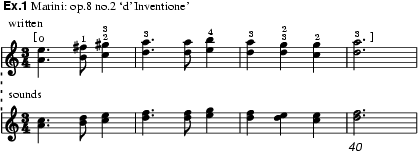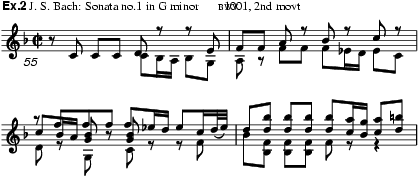
In the playing of bowed string instruments, the technique of sounding more than one note simultaneously. Playing on two strings at once is known as double stopping, three strings as triple stopping, etc. Although these terms imply creating notes by holding down (i.e stopping) several strings at once, chords or two part-passages which include open strings are also described as double (triple etc.) stops.
The technique of multiple stopping seems to have developed early among viol players. It is described in Ganassi’s Regola rubertina (1542–3). Chordal playing, highly developed by such exponents of the English lyra viol as Alfonso Ferrabosco (ii) and Tobias Hume at the beginning of the 17th century, seemed central to French Baroque composers. De Machy (Pièces de violle, 1685), went so far as to claim that pièces d’harmonie best suited the character of the viol and that simple melodic playing ‘should be compared to a person who could play the harpsichord or organ perfectly with one hand’. Christopher Simpson (The Division-Violist, 1659) and Thomas Mace (Musick’s Monument, 1676) both describe the bowing of chords; they emphasize that the lowest string should be sounded properly before the bow is moved across the other strings.
Double stops and chords appear in violin music early in the 17th century. They dominate several sections of Carlo Farina’s Capriccio stravagante (1627) and appear in various sonatas in Marini’s op.8 (1629), notably Sonata no.4 (inscribed ‘per sonar con due corde’) and Sonata no.2 ‘d’Inventione’ where the use of scordatura creates passages in parallel 3rds which are fingered as 5ths (using only one finger for each pair of notes – seeex.1).

Multiple stops become especially prominent in the works of late 17th-century German composers (Walther, Biber, Nicolaus Bruhns and J.P. von Westhoff). The fugal movements of Corelli’s op.5 contain complex double stopping – and these sonatas were imitated and their techniques extended by the next generation of composers. J.-M. Leclair was described in 1738 as ‘the first Frenchman who, imitating the Italians, played double stops, that is to say, played chords of two, three and even – by means of the thumb – up to four notes; and he has taken this kind of playing so far that the Italians themselves acknowledge that he is one of the first in the field’. The locus classicus of this kind of playing are the sonatas and partitas for solo violin (1720) by J.S. Bach. Ex.2, from the Fugue of the G minor sonata, shows the texture building up to four voices with each new entry. 14 of Kreutzer’s 42 Études (1796) focus on double stopping, and 19th-century virtuoso repertory (Paganini’s 24 Caprices, 1820, for example) is full of it. Spohr (Violin-Schule, 1832) described the technique as being ‘among the principal resources of the violin’.

Many difficulties arise in the reading of multiple stops in 17th- and 18th-century violin literature: what is written by the composer is often musically neither possible nor even desirable to play; it is therefore to be assumed that what is written is not what the composer expected to hear. Which notes to sustain in fugal movements often poses a problem. It is clear that some note values are indications of part-writing rather than prescribed durations. Even in Corelli’s music it is impossible to sustain every note in an interlocking chain of suspensions for its full written value, and Geminiani’s fingerings for fugal movements in his revised op.1 (1739) indicate that he did not always expect performers to sustain all notes for their full value (see Fingering, §II, 2).
The norm for triple or quadruple stops has always been to break the chords in some way. Quantz (1752) says that in playing chords ‘the lower strings must not be held … they must be struck quickly one after the other’. There are, in fact, numerous chords in 18th-century violin literature which must be arpeggiated, not because of the characteristics of the bow but because of the way the notes lie on the instrument. Both Leclair l’aîné and le cadet wrote some four-note chords which necessarily use only three strings. Veracini, too, has a number of such chords (ex.3). J.-A. Mathieu gives fingerings in his op.1 (1756) which demonstrate that he expected the bottom notes of a chord to be released in time for the player to re-use the same fingers for notes on higher strings (ex.4). In each of these cases, the player has no option but to make the chord ripple from bottom to top; the notes cannot be sounded simultaneously and sustained equally.


In Baroque music the word ‘arpeggio’ appears frequently; in other cases the performer must arpeggiate even without instruction, as in the Chaconne of Bach’s second partita for solo violin. In most cases the strings are stopped as for simultaneously sounding multiple stops, although the notes sound contiguously. Geminiani (The Art of Playing on the Violin, 1751) gave 19 ways of arpeggiating a chord progression.
Occasionally,
however, 18th-century composers specified that they did not want chords
arpeggiated. Leblanc, in his Sonata in E![]() , has a series of three-note chords together with the
instruction ‘Strike all three strings at once and always use a down-bow’. In
op.4 no.6 Leclair l’aîné indicates that he wants three notes sounded
together at the beginning of each group of oscillating notes. Pierre Baillot (
L’art du violon, 1834) listed among the beauties of the violin the fact
that it ‘lent itself so well to harmony that it could produce broken chords
like the harp and simultaneous chords like the piano – the first by means of
arpeggios, the second by chords struck simultaneously’.
, has a series of three-note chords together with the
instruction ‘Strike all three strings at once and always use a down-bow’. In
op.4 no.6 Leclair l’aîné indicates that he wants three notes sounded
together at the beginning of each group of oscillating notes. Pierre Baillot (
L’art du violon, 1834) listed among the beauties of the violin the fact
that it ‘lent itself so well to harmony that it could produce broken chords
like the harp and simultaneous chords like the piano – the first by means of
arpeggios, the second by chords struck simultaneously’.
The extent to which the development of the Tourte bow changed the way in which chords were treated by violinists is, in fact, quite hard to quantify. The idea that the convex bow sticks of the Baroque period facilitated the playing of chords as chords (an idea promoted by the advocates of the unhistorical ‘Bach bow’; see Bow, §I, 6) is a myth. If anything, early bows (which are lighter and have a greater separation between hair and stick at the frog) encourage the spreading of chords and, in comparison to the Tourte bow, are not so tolerant of the kind of force required to make more than two strings sound simultaneously.
It is in the 19th century that the practice seems to have developed (which can still be regarded as virtually standard) of breaking four note chords into two pairs, with the bottom pair held for only an instant and the top pair sustained. This method of execution is first unequivocally described by Spohr (1832) who writes of the excerpt shown in ex.5: ‘In executing four-part chords, the bow, close at the nut, is placed firmly to the two lower strings and brought, with a strong impetus, over to the two higher; the stroke being steadily continued upon the upper notes for their full duration … . The two lower notes, although frequently written in crotchets or minims, can be, at most, of only a semiquaver’s length’.
From Corrette's Méthode (1741) onwards nearly all cello treatises, with the exception of Crome's Compleat Tutor for the Violoncello (c1765), have something to say on the subject of fingering chords and double stops. Baumgartner (Instructions de musique … à l'usage du violoncelle, 1774) explains how to furnish self-contained chordal accompaniment for ‘ordinary’ (i.e. secco) recitative. The cello method of Jean-Louis Duport (Essai, 1806), which set the technical norm for modern cello playing, deals systematically with the subject of double stops. Solo cello repertory, too, has always made extensive use of chords and multiple stops. The Bach Suites (bwv 1007–12) are famous examples. Geminiani exploits the chordal possibilities of the cello in his six sonatas. Kodály's Sonata for solo cello, op.8 (1915), and the opening of the Elgar Cello Concerto (1919) stand out as memorable examples of the instrument's capacity for eloquent multiple stopping.

In the 20th century the methods of Auer, Flesch, Dotzauer and Piatti are standard texts for string players wishing to practise double stops. In the music of the 20th century complex multiple stops are common. The violin part of Stravinsky’s L’Histoire du Soldat abounds in chords and double stops; Stravinsky is very specific about the articulations for these passages and frequently instructs the player to perform three-note chords without arpeggiation (ex.6).

D.D. Boyden: The History of Violin Playing from its Origins to 1761 (London, 1965/R)
R. Stowell: Violin Technique and Performance Practice in the Late Eighteenth and Early Nineteenth Centuries (Cambridge, 1985)
PETER WALLS